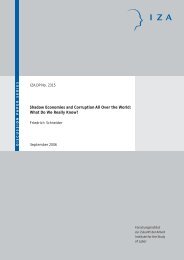The Great Recession of 2008-2009: Causes ... - Index of - IZA
The Great Recession of 2008-2009: Causes ... - Index of - IZA
The Great Recession of 2008-2009: Causes ... - Index of - IZA
- TAGS
- recession
- index
- ftp.iza.org
Create successful ePaper yourself
Turn your PDF publications into a flip-book with our unique Google optimized e-Paper software.
1980 and 1998, 958 SAPs were negotiated and implemented. Not surprisingly, the 1980s and<br />
1990s have been dubbed by some as the ‘Lost Decades’. <strong>The</strong> ‘Lost Decades’ seem to have<br />
emerged as a result <strong>of</strong> external factors, most notably the impact <strong>of</strong> the ‘slowdown in growth<br />
in the industrial world’. 4<br />
Focusing on the situation in advanced economies, other commentators have referred to the<br />
decades leading up to the crisis as the ‘<strong>Great</strong> Moderation’, a term attributed to the current<br />
Federal Reserve Governor, Ben Bernanke and other writers on the subject. 5 This claim refers<br />
to the decline in macroeconomic volatility over the last 25 years, following the crises <strong>of</strong> the<br />
1970s and 1980s. Bernanke (2004) states that the fall in macroeconomic volatility can be<br />
attributed to structural changes (meaning ‘changes in economic institutions, technology,<br />
business practices, or other structural features <strong>of</strong> the economy have improved the ability <strong>of</strong><br />
the economy to absorb shocks’) and improved macroeconomic policies. In 2004, the<br />
Governor <strong>of</strong> the Federal Reserve stressed that ‘improved monetary policy has likely made an<br />
important contribution not only to the reduced volatility <strong>of</strong> inflation ... but to the reduced<br />
volatility <strong>of</strong> output as well.’ At that time, this interpretation <strong>of</strong> recent economic history<br />
seemed to rest on ‘solid’ empirical evidence. However, this view contributed to the<br />
dangerous underestimation <strong>of</strong> risk (i.e. that low levels <strong>of</strong> macroeconomic volatility would<br />
continue), which was a major factor in the build-up to the crisis.<br />
Thus, the global and historical circumstances surrounding the emergence <strong>of</strong> the crisis <strong>of</strong> <strong>2008</strong><br />
and <strong>2009</strong> are subject to alternative interpretations. <strong>The</strong>y are either marked by a great deal <strong>of</strong><br />
optimism or afflicted by a dim view <strong>of</strong> the past. This dichotomy, in turn, reflects dualism in<br />
the global economy: countries which were gaining from globalization (OECD and emerging<br />
economies such as China and India) versus the losers (or the ‘not so strong gainers’) such as<br />
poorly integrated low-income countries.<br />
<strong>The</strong> global financial crisis has put some <strong>of</strong> these views into question, particularly the notion<br />
that monetary policy was doing a good job at maintaining stability. <strong>The</strong> problem as discussed<br />
4<br />
See Easterly (2001)<br />
5<br />
See the Remarks by Governor Ben Bernanke at the meeting <strong>of</strong> the Eastern Economic Association,<br />
Washington, DC on February 2004,<br />
http://www.federalreserve.gov/BOARDDOCS/SPEECHES/2004/20040220/default.htm. See also Baker (2007),<br />
Bernanke (2004), Blanchard and Simon (2001), and Reinhart and Rog<strong>of</strong>f (<strong>2008</strong>).<br />
7
















